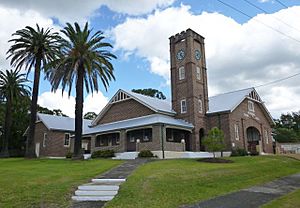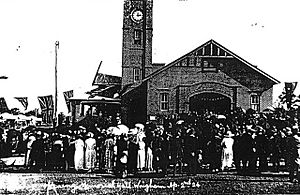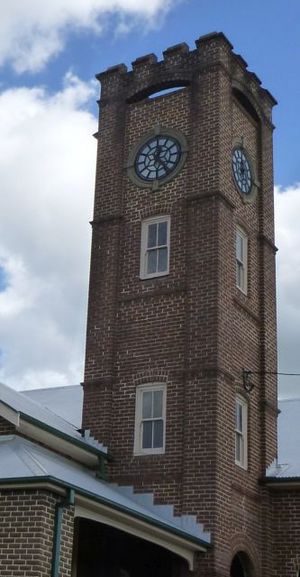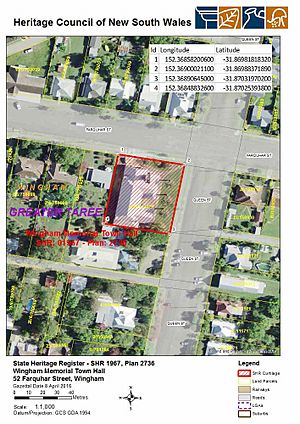Wingham Memorial Town Hall facts for kids
Quick facts for kids Wingham Memorial Town Hall |
|
|---|---|

Wingham Memorial Town Hall, viewed from corner of Farquhar and Queen Streets
|
|
| Location | 52 Farquhar Street, Wingham, Mid-Coast Council, New South Wales, Australia |
| Built | 1922–1924 |
| Architect | James T. Chambers |
| Owner | Mid-Coast Council |
| Official name: Wingham Memorial Town Hall; Wingham Town Hall; Wingham Council Chambers | |
| Type | state heritage (built) |
| Designated | 8 April 2016 |
| Reference no. | 1967 |
| Type | Hall Town Hall |
| Category | Community Facilities |
| Lua error in Module:Location_map at line 420: attempt to index field 'wikibase' (a nil value). | |
The Wingham Memorial Town Hall is a special historic building in Wingham, New South Wales, Australia. It's located at 52 Farquhar Street. Designed by James T. Chambers, it was built between 1922 and 1924. This important building is also known as Wingham Town Hall or Wingham Council Chambers. It is owned by the Mid-Coast Council and was added to the New South Wales State Heritage Register on April 8, 2016, because of its unique history and design.
Contents
A Look Back in Time
The Land Before European Settlement
Long before European settlers arrived, the Manning Valley was home to the Biripi and Worimi Aboriginal peoples. They had lived on and cared for this land for at least 20,000 years. Their lives were closely connected to the coast, lakes, and rivers, which provided plenty of food.
When European explorers like John Oxley first visited in the early 1800s, they noted how many Aboriginal people lived here. However, as Europeans settled, the traditional way of life for the Biripi and Worimi changed dramatically. Their food sources became scarce, and many faced hardship and illness. Despite these challenges, Aboriginal soldiers from the area bravely served in both World War I and World War II. Their names are honored on the rolls inside the Wingham Memorial Town Hall.
How Wingham Began
The first European explorer to cross the Manning River was John Oxley in 1818. Wingham was chosen as a government settlement because it was the furthest point inland that boats could reach on the Manning River. It was named after a town in England and officially became a village in 1844.
Wingham grew over time, becoming a municipality (a self-governing town) in 1889. Later, in 1981, Wingham and Taree joined together to form the City of Greater Taree. In 2016, this area became part of the larger Mid-Coast Council.
Remembering War Service
World War I (1914-1918) deeply affected Australia. Many young men from the Manning Valley volunteered to fight overseas. Sadly, a large number of them never returned home, and many others were seriously injured.
After the war, communities across Australia built memorials to remember those who served and those who were lost. These memorials were a lasting way to show respect and gratitude. Community halls were a popular choice for memorials. The Wingham Memorial Town Hall was opened in 1924 as one such tribute.
Building the Wingham Memorial Town Hall
The idea for a memorial hall in Wingham started during World War I. The community raised money for the project. To make sure the hall would last and be useful, it was decided to combine it with the town hall and council offices. The Wingham Municipal Council took over the project, getting a loan to help build it.
The architect, James Thomson Chambers, worked with builder F. C. Sweeney. They used local materials as much as possible. Bricks were made from local clay, and gravel for the foundations came from the Manning River. Timber for the building was sourced from nearby sawmills. Chambers even donated some timber from his own mill. This focus on local materials and workers was a key part of the Arts and Crafts movement, a design style popular at the time.
The foundation stone was laid by Charles Rosenthal, a decorated major-general from World War I. The Wingham Memorial Town Hall officially opened on April 2, 1924. The mayor at the time said the hall was a monument to the soldiers. He also promised it would always be available for soldiers and their families to use for free.
The Honour Rolls, which list the names of those who served, were also unveiled that day. To this day, ANZAC Day memorial services are held at the hall. A new memorial wall was added near the entrance in 2011. A clock, paid for by the women of Wingham, was later placed in the clock tower.
The Wingham Council used the building for its offices and meetings until 1981. After that, it continued to be used for various community events. It has hosted dances, wedding receptions, meetings, and even funerals. Community halls like this one played a big role in education and culture in the past.
The Town Hall as a Cinema
From 1924 to 1939, and again from 1948 to 1955, the Wingham Memorial Town Hall was also a cinema! The first "talkie" movie (a film with sound) was shown here on August 23, 1930.
One local resident, Stella Butterworth, shared a funny memory from the 1930s. She recalled a time when the sound on a film got stuck, making the hero repeat, "I'll have to be going, I'll have to be going" while kissing the girl. The audience found it hilarious! During the Great Depression, tickets cost one shilling and sixpence. Western movies were the cheapest and most popular. On a busy night, up to 400 people would come to watch a film.
The Architect: James Thomson Chambers
James Thomson Chambers (1870-1954) was an important architect from Sydney. He was born in Scotland and trained there. He moved to Wingham in 1918 to run a sawmill business. While in Wingham, he designed several buildings, including his own home, a church rectory, and other houses. He also designed the Wingham Memorial Town Hall.
Chambers was influenced by the Arts and Crafts movement, which focused on using local materials and skilled craftspeople. His designs in Wingham showed his unique flair and followed new trends like simple shapes and open verandas. He returned to Sydney in 1925.
Unique Design and Importance
The Wingham Memorial Town Hall is special because of its architectural style. It's designed in the Interwar California Bungalow style, which was usually used for homes, not large public buildings. This makes it quite rare and possibly unique for a civic building in New South Wales.
There are only a few other "memorial town halls" in NSW, like those in Tamworth and Manilla. Like Wingham, these buildings are now mostly used as community halls. The Wingham Memorial Town Hall is a great example of how communities honored their soldiers after World War I.
What the Hall Looks Like
The Wingham Memorial Town Hall is a distinctive brick building with a corrugated iron roof. It has large gables (the triangular parts of a wall under a sloping roof) and covered verandas. A unique feature is its castellated (castle-like) corner clock tower.
The building's design combines elements of the Interwar Californian Bungalow style, with its earthy look and low-pitched roofs, and the Federation Arts and Crafts style, seen in its large archway entrance and decorative woodwork. The clock tower is placed off-center, which is typical of the Federation Free Style.
The main entrance has a wide brick arch leading into an open vestibule (a small lobby). Inside, there's a charming ticket booth with leadlight windows. The clock tower stands about 15 meters tall, with a circular clock face on each side and a crenelated (notched) top.
The main hall itself is quite large, measuring about 24 meters by 12 meters, and could seat 600 people. It also has a stage, changing rooms, a supper room, and a kitchen. The original council offices were also in the building. The clock, which cost 225 pounds, was donated by the women of Wingham through fundraising.
Today, the interior of the hall is mostly off-white. The clock faces now use modern electric mechanisms to keep accurate time. The original clock mechanism is on display at the Wingham Museum.
The World War I Honour Rolls are still displayed in the foyer. They list 1047 names, covering service from the Soudan War in 1885 all the way to Iraq in 2003. This includes 232 names from World War I and 696 from World War II. The symbols of the Royal Australian Air Force, Army, and Navy are also displayed above the main doors.
While some original features like the street fencing have been removed, the building is still in good condition. It continues to be used by various community groups.
Changes Over Time
The Wingham Memorial Town Hall has seen some changes since it was built:
- 1950s: A ticket booth was added in the vestibule.
- Around 1969: The original brick fence around the building was removed.
- 1970: The veranda was enclosed.
- Around 1985: The clock tower's original time-keeping mechanism was replaced with an electronic system.
- 1995: Toilets were installed inside the building.
- 1999: The kitchen was updated.
- 2002: The main hall was refurbished.
- 2003: The verandas were restored to their original open design.
- 2010: The corrugated roof was replaced after hail damage.
- 2011: A Cenotaph and Remembrance Wall were installed near the entrance foyer.
- 2015: The office spaces were repaired and repainted.
Why It's a Heritage Site
The Wingham Memorial Town Hall is listed on the New South Wales State Heritage Register because it's very important.
- Historical Significance: It shows how local government worked in Wingham before the council amalgamations in 1981.
- Architectural Beauty: Its design is considered beautiful and unique. It's a landmark building on the Mid North Coast. The use of the Interwar California Bungalow style for a civic building is rare. Its strong design, dramatic entrance, and off-center clock tower make it stand out.
- Rarity: It's one of only three known memorial town halls in NSW. Its architectural style for a civic building is also very rare.
- Representative Importance: It's a great example of a high-quality regional town hall. Its role as a war memorial shows how important "remembrance" is in Australian culture. It also represents a community hall that brings people together for social and cultural events, including its past as a local cinema.




